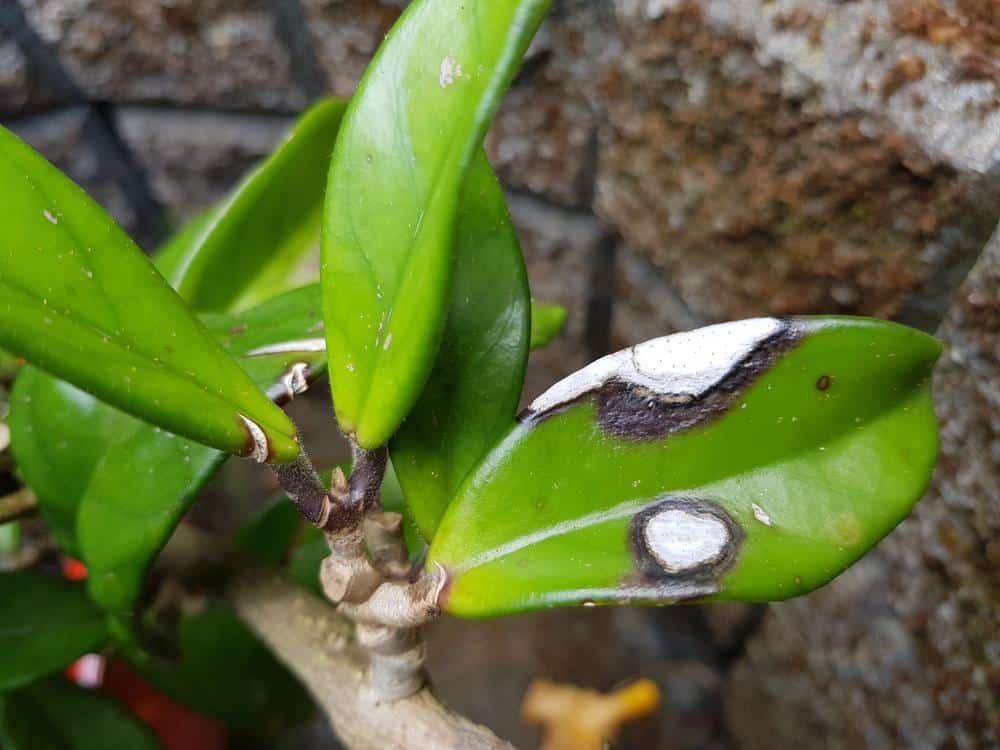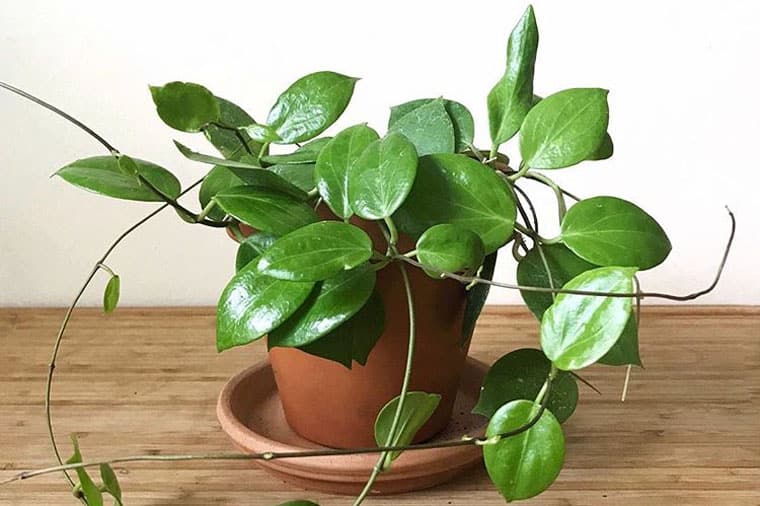Hoya plants are famous for their colorful and fragrant flowers. The strong green leaves and small flowers arranged in jars form a colorful picture. Many people love to grow this plant in the home or office because they are easy to grow, easy to care for, and can adapt to many different living conditions.
You don’t need to spend too much time and money growing this plant indoors. However, you may also encounter some common situations of foliar diseases, fungal diseases, insects, or hoya plants’ health problems. Let’s find out detailed information about Hoya plant problems in the article below.
Hoya Leaf Problems – Common Leaf And Health Problems Of Hoya Plants
The health of any plant will soon show up in the leaves. Observe the health signs of hoya plants through the leaves. The basic signs are the leaves turning yellow, and brown, the appearance of brown spots, black spots, leaves rolled up or leaves are dry. Below is detailed information on the health status of hoya plants through foliar expression.
The Leaves Of Hoya Plants Turn Yellow
The leaves of this plant turning yellow can be related to a variety of reasons. One of the common reasons is improper watering, lack of sunshine, or lack of nutrients. If you notice the leaves of your hoya plants starting to turn yellow, change the frequency of watering.
Most hoya plants prefer dry soil between waterings. This plant needs more water in summer and less water in winter. Before watering you need to use a moisture meter or finger to check the moisture in the soil. You should only water when the ground is 2-3 inches dry.
The second factor that affects the color change of leaves is light. Hoya plants need at least 6 hours of sunlight per day for gas exchange and photosynthesis. Lack of light will lead to stunted growth of this plant. Look for a suitable location that ensures at least 6 hours of indirect sunlight per day to help keep your hoya plants healthy. However, a location with too many hours of intense sunlight will burn the leaves and dehydrate the hoya plants.
The leaves of Hoya plants turning yellow can also be due to a nutrient deficiency. Nutrition plays an extremely important role in plant growth and maintaining the green color of leaves. Nitrogen deficiency will affect the maintenance of green color and chlorophyll in leaves. Therefore, you should periodically fertilize during the growing season to enhance nutrients in the soil.

Brown Spots, And Black Spots Appear On Leaves
The appearance of brown and black spots on the leaves of hoya plants can be related to pests, fungal and bacterial diseases, or improper watering. Hoya plants are the favorite plants of several insects such as scale insects, spider mites, and mealybugs. Generally, hoya plants grown outside in their natural environment are more susceptible to insect attacks than indoor hoya plants.
If you detect the presence of insects and vermin, you can use neem oil or insecticidal soap to kill them. In addition, you should regularly clean the two sides of the leaves to remove layers of plaque and insect eggs.
If you can’t find signs of insects and bugs attacking the hoya plant, the cause of the black and brown spots that appear may be related to a fungal or bacterial infection. You need to remove the leaves that are infected with fungi and bacteria. Then, use specialized fungicides to limit the ability of plants to spread and maintain plant health.
If brown and black spots appear not due to insects or fungi, you should pay attention to waterlogging. Waterlogging causes the root system to rot, unable to exchange air and transport nutrients to the leaves. Metabolism, photosynthesis, and plant movement will be disrupted. As a result, the cells of the leaves will die and become deformed, and brown and black spots will form.
Check for waterlogging and improve drainage to promote faster drying of the soil. You should also replace the soil with fresh soil and new pots to prevent bacteria and fungi from accumulating in the soil. Stop watering until the soil is completely dry and the plants are fresh again.
The Leaves Of Hoya Plants Are Curled
Environmental stress such as waterlogging, low humidity, and sudden temperature changes all affect the leaves of the hoya plant. This plant prefers temperatures in the 60 to 80 degrees Fahrenheit range. If the humidity is too low, you should use a humidifier to maintain the humidity in the room. In addition, you can also apply some methods to increase humidity such as misting several times a day and placing potted plants next to the aquarium or water trays to take advantage of moisture rising from the water. Grouping plants next to each other is also a way to take advantage of moisture through the plant’s gas exchange.
Place the potted plant in an area where the temperature is warm and away from strong winds in winter. Cold winds and frost will cause the leaves to curl up to reduce the area exposed to frost. In addition, curled leaves of hoya plants are also associated with leaf burn. When plants are exposed to direct sunlight with high intensity for a long time, the cells become dehydrated and deformed. So the leaves will dry and roll up to reduce the area exposed to the sun.
Massive Leaves Fall
Defoliation is a natural phenomenon of plants with older leaves. However, the young leaves that also fall in mass will be a warning sign of the plant’s health. Some of the causes of mass defoliation of hoya plants are waterlogging low humidity, and lack of nutrition.
You need to re-examine environmental factors and plant care routines on a daily basis. Hoya plants need at least 6 hours of sunlight a day, so you can use lamps to provide artificial light for this plant. Make sure the plant’s soil is loose and well-drained. Water regularly during the growing season when the ground is 2 inches dry. Over-watering will cause plants to become waterlogged, root rot, and lose leaves.
Lack of nutrients is also a factor that causes leaves to fall. You should fertilize regularly during the growing season. Use organic fertilizers, slow-release fertilizers, or liquid fertilizers to maintain plant nutrients. Nutrition will help plants stay healthy, maintain the green color of the leaves, and resist the negative effects of the natural environment.

Flower Buds Fall Before Blooming
After a long wait and care, the first flower buds will appear. You are eagerly waiting for the flowers with vibrant colors. However, you discover that these flower buds start to fall off soon after. What happened to these flower buds? The answer is that the plant’s health is in serious trouble.
The main cause of this condition is too much water or too little water. Too much water leads to waterlogging, from which the tips will be severely affected and unable to keep the flower buds. Meanwhile, lack of water makes plants not have enough water to transport plant parts. From there, the cells are broken, and both flowers and leaves will fall off due to a lack of water and energy to maintain.
Propagation Of Hoya Plants Often Fails
Many people complain about how difficult it is to propagate hoya plants because they repeatedly fail despite varying approaches. Propagation of hoya plants is relatively time-consuming and you need to be patient to take care of this process. Propagation of this plant by cuttings is not always successful as the branches may not grow new roots.
Soil propagation also tends to suffer from root rot from waterlogging or fungal diseases. Natural environmental conditions are also a factor that makes propagation difficult. You need to choose a suitable and favorable time to propagate hoya plants. You should choose the time of propagation in the growing season so that the plants have the most ideal natural environment. Propagation should not be carried out in winter or during a drought period as the young plants will die.
You should carry out the propagation of hoya plants in water. Take cuttings of hoya plants in a glass vase to observe the plant’s rooting process. You need to change the water every 3 days to avoid dirty water and root rot. Do not place the vase containing the propagation stem in direct sunlight. Instead, you should place them in an area with shade and warm light to create favorable conditions for new roots to develop.
Plants Do Not Flower
Hoya plants will take at least two years to bloom their first flowers. However, depending on the variety of plants and the conditions of care, the flowering time of this plant can be different. Besides, some plant care habits also make flowering time longer such as lack of sunlight, waterlogging, root rot, or lack of nutrition.
Hoya plants take several years to flower, but you can shorten the flowering period by placing the pot in an area that gets a few hours of sun each day. An adult hoya plant can be grown in a 5-inch pot due to its short root system. In fact, potted hoya plants can stimulate flowering earlier because the energy is not so focused on developing more branches.
Pests And Ants Attack Due To The Fragrance And Sweetness Of Flowers
Hoya plants can be easily infected with insects and pests such as mealybugs, spider mites, scale insects, leaf spots, and root rot. In particular, ants can also attack hoya plants when the flowers appear. The flowers of hoya plants are brilliant in beauty, fragrant, and sweet in taste. Therefore, insects and ants are very fond of enjoying this sweetness.
Mealybugs: They are small, white, hairy insects. This insect is commonly found on the leaves, stems, and flowers of hoya plants. Mealybugs will suck the sap of leaves and stem, from which plants will weaken and die. To kill this insect, you should use insecticidal soap, neem oil, and alcohol.
Spider mites: Spider mites are small insects that have a spider-like appearance. They suck the sap directly from the leaves and stems, so the leaves of the hoya plants will turn yellow and fall off en masse. To kill this insect, you should isolate the plant from other plants to avoid infection. Use neem oil or insecticidal soap to kill these insects.
Scaly insects: They are small, oval-shaped insects that often appear on the leaves and stems of hoya plants. They also suck the sap directly from the leaves and stems of hoya plants. The leaves of the plants will also turn yellow or brown and fall off en masse.
Leaf spot: Leaf spot is a disease caused by a fungus and its manifestation is brown and black spots appearing on the leaves. To prevent leaf spots, avoid over-watering and place the pot in an area with good air circulation. Use specialized fungicides to kill fungal diseases.
Root rot: Root rot is associated with a fungus that attacks the root system of plants. The cause of root rot is long-term waterlogging. Proper watering and watering when the ground is dry is the best way to prevent root rot.
Final Thoughts
Hoya plants are plants that many people love to grow in homes and beauty offices. This plant has lush green foliage, huge inflorescences, vibrant colors, and a sweet fragrance. Some common problems with this plant are leaf discoloration, leaves with black spots, brown spots, leaves curling, leaves falling in mass, flower buds falling off before blooming, and plants not flowering or breeding often fails.
Maintain plant health by watering properly, and moving the pot to an area with warm sun and afternoon shade. In addition, you also need to use neem oils or insecticidal soaps to kill insects. Avoid waterlogging and humid environments that will create conditions for fungi and insects to grow.